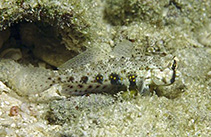| Family: |
Gobiidae (Gobies), subfamily: Gobionellinae |
| Max. size: |
5.5 cm SL (male/unsexed) |
| Environment: |
reef-associated; marine; depth range 0 - 12 m |
| Distribution: |
Western Pacific: relatively restricted from the Cocos-Keeling Islands, Philippines, Taiwan, southern Japan, Indonesia, New Guinea, Solomon Islands and Vanuatu. |
| Diagnosis: |
This moderate-sized (up to 55 mm SL) species has a distinctive colour pattern: in males, with 6 broad vertical dark blotchy bars along mid-side of body, several staggered rows of black spots along the dorsal part of the body, 1-4 irregular rows of golden yellow (in life) spots along lower half of body, 2 characteristic small black spots at base of first dorsal fin, and 1-3 staggered rows of oval black ocellate spots on anal fin (in life, red, blue and yellow may surround black spots); in females, with vertical dark body bars much paler and red and yellow markings much less distinct; D2 and anal fin rays nearly always I,11; pectoral rays 15-17 (usually 16); lateral scales 24-30 (usually 26); predorsal scales 9-10 (usually 8-9), ctenoid and cycloid (Ref. 92171). |
| Biology: |
Found in shallow waters, from reef tidepools, among seagrass, in shallow mangroves and (usually) sand and coral rubble reef substrates at depths of 0.2-12 m (Ref. 92171). |
| IUCN Red List Status: |
Least Concern (LC); Date assessed: 13 March 2015 Ref. (130435)
|
| Threat to humans: |
harmless |
Source and more info: www.fishbase.org. For personal, classroom, and other internal use only. Not for publication.
